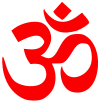|
Avadhuta Gita
Avadhuta Gita (Devanagari: अवधूत गीता, IAST: Avadhūta Gītā) is a Sanskrit text of Hinduism whose title means "Song of the free soul".[1] The text's poetry is based on the principles of Advaita and Dvaita schools of Hindu philosophy.[2][3][4][5] The text is attributed to Dattatreya,[6] and extant manuscripts have been dated to approximately the 9th or 10th century CE. It consists of 289 shlokas (metered verses), divided into eight chapters.[1] The first seven chapters are the text's oldest layer, and the eighth chapter is likely a later interpolation.[7] It may have been composed in the deccan states of India, probably Maharashtra.[8] Avadhuta Gita has been one of the most important texts of the Natha Yogi tradition of Hinduism.[8] DateAbhayananda states, "The actual date of authorship of the Avadhut Gita is unknown, but, judging by its terminology and style, it appears to have been written, not in the millennia prior to the Current Era, as legend would have it, but sometime around the 9th or 10th centuries of our Current Era. This does not, of course, preclude the possibility of an oral transmission to that point in time."[9] NameThe title of the text, Avadhuta means "liberated soul", while Gita means song.[2] The text describes the nature and the state of a person who is spiritually free and liberated.[2][10] The text is also known as Avadhuta Grantha, Dattatreya Gita, Datta Gita Yoga Shastra and Vedanta Sara.[11] Contents
The Avadhuta Gita is structured in 8 chapters, wherein Dattatreya—the symbol of the highest yogi and monastic life—describes as the divine master and example, the journey of self-realization, thereafter the nature and state of a person who lives in his soul's truth.[14][15] Dattatreya asserts in the text, that the self-realized person is "by nature, the formless, all pervasive Self".[2][16] He is in the state of sama-rasya or samata, which is where there are no differences between anything or anyone, neither one own's body or another person's, neither class nor gender, neither human being nor other living beings, between the abstract and the empirical universe, all is one interconnected reality, it is the unification of the One and the Beyond.[17][15] His universe, all of the universe, is within his Atman (soul).[17] "There is never any you and I", states verse 6.22.[18] The chapters discuss 'contemplation', states Rigopoulos, as well as "sahaja amṛitam" 'nectar of naturalness'.[19] Some of its teachings have been compared to the Bhagavad Gita.[19] The term Sahaja, that became important in both Hindu and Buddhist tantric traditions, means "transcendent Reality, or Absolute". It is equated to Sunya (void) in Buddhism, envisioned as a kind of "unlocated paradise", states Rigopoulos. In Hinduism, it is the interior Guru within the person, the Sadashiva, the all pervading ultimate Reality (Brahman) that is the Atman (Self) within.[20] Translation
ReceptionThe text has been influential on the Nath tradition of Hinduism, states Rigopoulos, and its teachings form a foundation of their Sama-rasya doctrine:
Passages of the text are found in numerous Hindu texts, such as in the widely translated Bhagavata Purana, which is the most popular Purana, where verses 8.2 to 8.4 of Avadhuta Gita appear as verses 11.11.29-11.11.31 as one example. The text's nirguni Brahman ideas influenced the poetry of Kabir, states Rigopoulos.[23] Vivekananda (1863–1902) held the Avadhuta Gita in esteem and he translated aspects of it in the following talk he gave on July 28, 1895, transcribed by his disciple Waldo:
See alsoReferences
Bibliography
External linksWikisource has original text related to this article:
|
Portal di Ensiklopedia Dunia

